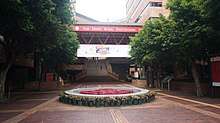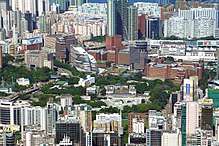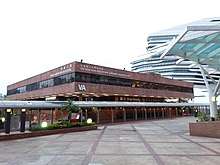Hong Kong Polytechnic University
The Hong Kong Polytechnic University (PolyU) is a public research university located in Hung Hom, Hong Kong. The history of PolyU can be traced back to 1937. It became a fully accredited university and one of the government-funded degree-granting tertiary institutions in 1994.
香港理工大學 | |
 | |
| Motto | 開物成務 勵學利民[1] |
|---|---|
Motto in English | To learn and to apply, for the benefit of mankind[2] |
| Type | Public |
| Established | 1937, as Government Trade School 1947, as Hong Kong Technical College 1972, as Hong Kong Polytechnic 1994, granted university status[3] |
| Chairman | Lam Tai-fai |
| Chancellor | Chief Executive of Hong Kong (Current officeholder: Carrie Lam) |
| President | Teng Jin-guang |
| Provost | Alexander Wai |
Academic staff | 1,230[4] |
| Students | 25,827[4] |
| Location | , , 22°18′18″N 114°10′48″E |
| Campus | Urban 9.46 hectares (0.0946 km2)[5] |
| Colours | Red and grey[6] |
| Website | polyu |
| Hong Kong Polytechnic University | |||||||||||||
|---|---|---|---|---|---|---|---|---|---|---|---|---|---|
| Traditional Chinese | 香港理工大學 | ||||||||||||
| Simplified Chinese | 香港理工大学 | ||||||||||||
| Cantonese Yale | Hēunggóng Léihgūng Daaihhohk | ||||||||||||
| |||||||||||||

PolyU consists of 8 faculties and schools, offering programmes covering applied science, business, construction, environment, engineering, social science, health, humanities, design, hotel and tourism management.
The university offers over 160 taught programmes for more than 25,800 students every year.[7] It is the largest public tertiary institution in terms of number of students. As of 2020, the university ranks 25th in Asia by THE,[8] 15th in young universities by THE, and 75th internationally by QS.[9]
History
The Government Trade School was founded in 1937. Situated at Wood Road, Wan Chai, the school was the first publicly funded, post-secondary technical institution in Hong Kong. After World War II, the school became the Hong Kong Technical College in 1947, and opened new premises in Hung Hom in 1957.
In 1972, the Hong Kong Polytechnic was formally established. Its mandate was to provide professional-oriented education to meet the need for qualified workers. It gained approval from the University and Polytechnic Grants Committee (UGC) for self-accreditation of degree programmes on 25 November 1994, granting full university status and changing its name to The Hong Kong Polytechnic University.
Campus
Main campus
PolyU's main campus, in Hung Hom, Kowloon, was designed by a team led by James Kinoshita from P&T Group in 1972.[10][11] It has over 20 buildings with red-brick walls, many of which are inter-connected and raised one floor above the podium, creating sheltered open-air spaces for multi-purposes such as logistics and parking.[12] Apart from buildings named after donors, the rotundas which connects the buildings are identified in English letters (from cores and blocks A to Z, without K, O and I). It is one of the largest and densest educational campus in the world.[13]

Block Z is the eighth phase of the campus expansion project. It is situated across the northwestern side of the main campus, separated by Chatham Road. It can be accessed through a pedestrian tunnel or a 80-meter-long footbridge, which was proposed in 2016 and built in 2019.[14]
In addition to classrooms, laboratories and other academic facilities, the university provides a multi-purpose auditorium, recreational and catering facilities, medical facilities, as well as a bookstore and banks. The Jockey Club Auditorium began operation in 2000. Its balcony and main floor seating accommodate up to 1,084 persons.
There are multiple sports facilities, including two swimming pools (Block X and Michael Clinton Swimming Pool), 2 indoor sports grounds (Shaw Sports Complex and Kwong On Jubilee Sports Centre), an outdoor sports ground (Keith Legg Sports Field) with basketball and soccer fields and jogging track, 2 outdoor tennis courts, and a joint-sports centre.
Pao Yue-kong Library

The library was established on 1 August 1972.[15] Two centres operated until 1976 at Hung Hom and Quarry Bay, merging into the present building in 1976. It was named after shipping entrepreneur and philanthropist Yue-Kong Pao in 1995.
In 2014, there were over 2.77 million of library holdings in total, with nearly 600,000 electronic resources. The six-storey library provides 3,900 study spaces and is equipped with a 24-hour study centre and audio-visual information areas.
In 2017, the library has renovated its 3/F & 4/F and named it as i-space which contains services such as VR Experience Zone, Internet of Things (IoT), Laser Cutting / Engraving, 3D Scanning, Book Scanning, Large Format Printing, Vinyl Cutting and 3D Printing. There is also area for video production on 3/F such as One button studio and Digital Studio.
Innovation Tower
The Innovation Tower is located at the northwestern side of the university campus. This 15-story building provides 15,000 square metres of net floor area. It houses facilities for the School of Design, including exhibition areas, multi-functional classrooms and lecture theatres, design studios and workshops, as well as a communal lounge. The tower was designed by Zaha Hadid.
Teaching and research hotel
Hotel Icon was officially opened in September 2011. The hotel is wholly owned by the university as a teaching and research hotel of the School of Hotel and Tourism Management.
Community college
Established in 2001 under the auspices of PolyU, the Hong Kong Community College (HKCC) is a self-financed post-secondary institution which offers associate degree and higher diploma programmes spanning the domains of arts, science, social sciences, business, health care and design for senior secondary school leavers. HKCC classes are conducted at the Hung Hom Bay and West Kowloon campuses.[16]
Academics
Faculties and schools
The University's teaching units are grouped under 8 faculties and schools, offering over 150 postgraduate, undergraduate taught programmes.[17]
| Faculty of Applied Science and Textiles | Faculty of Business | Faculty of Construction and Environment |
|---|---|---|
|
|
|
| Faculty of Engineering | Faculty of Health and Social Sciences | Faculty of Humanities |
|
|
|
| School of Design | School of Hotel and Tourism Management | College of Professional and Continuing Education (CPCE) |
|
Research
PolyU's research focus areas include: aerospace, aviation, big data and AI, food safety, health science, infrastructure monitoring, intelligent construction, sustainability and smart city. To facilitate the implementation of cross-disciplinary research through collaborations among faculties and schools and other local and overseas institutions and partners, PolyU established a wide variety of research laboratories, institutes and centres, e.g. the Aviation Services Research Centre with Boeing.[18][19]:
Reputation and rankings
| University rankings | |
|---|---|
| Global – Overall | |
| ARWU World[20] | 201-300 (2020) |
| THE World[21] | 171 (2020) |
| QS World[22] | 75 (2021) |
| Regional – Overall | |
| THE Asia[23] | 24 (2020) |
| QS Asia[24] | 25 (2020) |
World Rankings of PolyU
- QS "Top 50 Under 50" list of world's top young universities (2020): 6th in the world, 3rd in Hong Kong[25]
- QS Asian University Rankings 2020: 25th in Asia, 5th in Hong Kong
- QS World University Rankings 2021: 75th in the world, 5th in Hong Kong
- Times Higher Education's World University Rankings 2020: 171st in the world
- Times Higher Education's 200 Under 50 World University Rankings 2016: 19th in the world
- Times Higher Education's Asia University Rankings 2020: 17th in the Asia, 24th in Hong Kong
World Rankings of Faculties, Schools and Disciplines
| Faculty of Applied Science and Textiles |
|
| Faculty of Business |
|
| Faculty of Construction and Environment | |
| Faculty of Engineering |
|
| Faculty of Health and Social Sciences | |
| Faculty of Humanities | |
| School of Design |
|
| School of Hotel and Tourism Management |
|
Student life
Student halls
There are two student halls of residence buildings provided by the university, in Hung Hom Bay and Ho Man Tin. The residential halls include:
- Hung Hom Bay – Research Postgraduate: Boyan Hall (19,20/F). Undergraduates: Kaiyuan Hall (17,18/F), Wuhua Hall (15,16/F), Chengde Hall (13,14/F), Wuxian Hall (11,12/F), Lizhi Hall (9,10/F), Lisheng Hall (5,6/F), Minyin Hall (3,4/F). Female residents: Xuemin Hall (7,8/F).
- Ho Man Tin – Co-ed halls for both all students: 3-7/F (Purple), 5-9/F (Blue), 10-14/F (Green), 12-16/F (Yellow), 17-21/F (Orange), 19-23/F (Red), 24-25/F is warden's floor.
The university also provides three off-campus housing sites, located in Sham Shui Po, Mong Kok, and Tsim She Tsui. It offers around 250 residential places at urban areas, as an accommodation option for non-local students.
Student organization

The Hong Kong Polytechnic University Students’ Union (HKPUSU) is a student-run organization that is autonomous from the University administration for promoting the interests and welfare of full-time undergraduates (excluding postgraduate and College of Professional and Continuing Education students).
Sports teams
- Athletics
- Badminton
- Basketball
- Fencing
- Handball
- Karate-do
- Rowing
- Rugby
- Soccer
- Squash
- Swimming
- Table Tennis
- Taekwondo
- Tennis
- Volleyball
- Woodball
Incidents
Democracy wall controversy
The university's faculty-led Student Discipline Committee, with the support of the university council chairman Lam Tai-fai,[44] expelled one student and suspended another for one year in response to an October 2018 incident arising from a dispute over postings by students on the "Democracy Wall" bulletin board then managed by the students' union. The students had posted messages in commemoration of the fourth anniversary of the "Umbrella Movement" democracy occupation protests of 2014 and calling for Hong Kong independence from the CCP-ruled People's Republic of China. Another two students were ordered to serve terms of community service. The students had been ordered by management to take them down.[45]
The evidence called at the disciplinary committee hearing, at which the students were denied legal representation, included video footage in which the students were observed shouting and knocking on doors. It was alleged that they had made defamatory comments, assaulted a staff member and damaged property, all of which accusations were denied by the students. The university described their behaviour as "unruly". Among them were a former student union leader, an elected member of the school's governing council and a former external vice-president of the student union. No avenue for appeal from a decision of the committee is available.[46]
Numerous pro-democracy groups, including more than a dozen legislators and 19 student organisations, protested the decision of the committee. The 90,000-strong Hong Kong Professional Teachers' Union described the punishments as excessive.[47]
2019 campus siege
In November 2019, the university was occupied by protesters as part of the 2019–20 Hong Kong protests, confrontation with the Hong Kong Police Force occurred from 17 November to 19 November. On 16 November, police attempted to enter the campus, but failed as protestors used road blocks and petrol bombs to attack them.[48][49][50][51] The police then blocked all exits of the university campus and requested all protesters inside to surrender. On 18 November, the police attempted to enter the campus again using tear gas, rubber bullets, bean bags, and sponge grenades.[52] Protestors responded by throwing petrol bombs at police.[53] The university has been described as being a battleground during the conflict.[54] The university was later sealed off by police, only several protesters managed to escape.[55] This resulted to a 3-days long stand off. More than 280 protesters were injured while more than 1,000 persons were arrested.[56]
Notable alumni
References
- "校訓、願景及使命 (Chinese)". HK Polytechnic U. Retrieved 17 July 2014.
- "Motto, Vision and Mission (Chinese)". HK Polytechnic U. Retrieved 17 July 2014.
- "Four stages of development". HK Polytechnic U. Retrieved 29 November 2019.
- "Facts and Figures". HK Polytechnic U. Retrieved 14 August 2018.
- "About the Campus – The Hong Kong Polytechnc University". Retrieved 2 April 2013.
- "The Hong Kong Polytechnic University – Identity Guidelines". Yale.edu. Retrieved 4 December 2011.
- "Facts and figures PolyU". Retrieved 24 July 2020.
- "Asia University Rankings". Times Higher Education (THE). 26 April 2019. Retrieved 18 August 2019.
- "The Hong Kong Polytechnic University". Top Universities. 2020. Retrieved 13 June 2020.
- "Yau Tsim Mong District" (PDF). Electoral Affairs Commission. Retrieved 30 August 2019.
- Dewolf, Christopher (3 October 2019). "Hong Kong's Modern Heritage 9: PolyU - James Kinoshita & Zaha Hadid". Zolima City Magazine. Retrieved 17 April 2020.
- "Where does PolyU's signature red brick architecture come from?". PolyU. Retrieved 17 April 2020.
- Group, P&T. "Hong Kong Polytechnic University - P&T Group". web.p-t-group.com. Retrieved 19 April 2020.
- "Hong Kong Polytechnic University footbridge planned". www.info.gov.hk. Retrieved 17 April 2020.
- "History". Lib.polyu.edu.hk: The University Learning Hub. Retrieved 9 December 2014.
- "PolyU Campus". Hong Kong Polytechnic University website. Hong Kong Polytechnic University. Retrieved 13 March 2019.
- "Faculties, Schools & Departments - PolyU". The Hong Kong Polytechnic University. Retrieved 13 October 2019.
- "About". The Aviation Services Research Centre. Retrieved 9 December 2014.
- https://www.polyu.edu.hk/research/labs-institutes-centres/ PolyU Research
- "ARWU World University Rankings 2020 - Academic Ranking of World Universities 2017 - Top 500 universities - Shanghai Ranking - 2020". www.shanghairanking.com. Retrieved 13 June 2020.
- "World University Rankings". 13 June 2020. Retrieved 13 June 2020.
- "QS World University Rankings 2018". 5 June 2017. Retrieved 14 March 2018.
- "Asia University Rankings". 13 June 2020. Retrieved 13 June 2020.
- "QS University Rankings: Asia 2019". 6 June 2018. Retrieved 6 June 2018.
- "QS University Rankings: Top 50 Under 50 2019".
- "QS World University Rankings by Subject 2020 - Statistics & Operational Research". Retrieved 29 July 2020.
- "QS World University Rankings by Subject 2020 - Business & Management Studies". Retrieved 29 July 2020.
- "QS World University Rankings by Subject 2020 - Accounting & Finance". Retrieved 29 July 2020.
- "THE World University Rankings 2020 by subject: business and economics". Retrieved 29 July 2020.
- "The UTD Top 100 Worldwide Business School Rankings Based on Research Contributions (All Journals)".
- "QS World University Rankings by Subject 2020 - Engineering - Civil & Structural". Retrieved 29 July 2020.
- "QS World University Rankings by Subject 2020 - Architecture / Built Environment". Retrieved 29 July 2020.
- "QS World University Rankings by Subject 2020 - Engineering - Electrical & Electronic Manufacturing". Retrieved 29 July 2020.
- "QS World University Rankings by Subject 2020 - Computer Science & Information Systems". Retrieved 29 July 2020.
- "THE World University Rankings 2020 by subject: engineering and technology". Retrieved 29 July 2020.
- "THE World University Rankings 2020 by subject: computer science". Retrieved 29 July 2020.
- "QS World University Rankings by Subject 2020 - Nursing". Retrieved 29 July 2020.
- "THE World University Rankings 2020 by subject: social sciences". Retrieved 29 July 2020.
- "QS World University Rankings by Subject 2020 - Linguistics". Retrieved 29 July 2020.
- "THE World University Rankings 2020 by subject: arts and humanities". Retrieved 29 July 2020.
- "QS World University Rankings by Subject 2020 - Art & Design". Retrieved 29 July 2020.
- "QS World University Rankings by Subject 2020 - Hospitality & Leisure Management". Retrieved 29 July 2020.
- "A World Ranking of the Top 100 Hospitality and Tourism Programs" (PDF). Retrieved 10 June 2015.
- "PolyU chair backs action on students in Democracy Wall protest". EJ Insight. Hong Kong Economic Journal. 4 March 2019. Retrieved 9 March 2019.
- "Hong Kong Student Is Expelled Over 'Democracy Wall' Protest". Bloomberg. 2 March 2019. Retrieved 10 March 2019.
- Chan, Holmes (4 March 2019). "Hong Kong Polytechnic University sees backlash after student expelled over 'free speech' protest". Hong Kong Free Press. Retrieved 10 March 2019.
- Leung, Mimi (4 March 2019). "Anger at punishment for students' pro-independence posts". University World News. Retrieved 10 March 2019.
- Wong, Edward; Ives, Mike; Mays, Tiffany; Li, Katherine (17 November 2019). "Hong Kong Violence Escalates as Police and Protesters Clash at University". The New York Times. Retrieved 18 November 2019.
- Moritsugu, Ken (18 November 2019). "Hong Kong police battle protesters trying to escape arrest". AP News. Retrieved 18 November 2019.
- Pang, Jessie; Pomfret, James (17 November 2019). "Choking and crying, Hong Kong protesters pinned back on campus". Reuters. Retrieved 18 November 2019.
- https://www.theguardian.com/world/2019/nov/17/fire-rocks-and-teargas-fly-in-day-of-battle-at-hong-kong-university
- "Hong Kong Polytechnic University: Protesters still inside as standoff continues". www.bbc.co.uk. The BBC. Archived from the original on 20 November 2019. Retrieved 20 November 2019.
- Prescott, Katie. "Hong Kong: 'I was tear gassed getting my lunch'". www.bbc.co.uk. The BBC. Archived from the original on 16 November 2019. Retrieved 20 November 2019.
- "Hong Kong Polytechnic University: Protesters arrested as they run from campus". BBC. 18 November 2019. Retrieved 18 November 2019.
...In the past week, Polytechnic University has turned into a "battleground" as the long-running Hong Kong protests become more violent...'
- "At embattled Hong Kong university, a dramatic escape". Reuters. 18 November 2019. Retrieved 18 November 2019.
- "Hong Kong protests: 1,100 people arrested in a day, 3,900 petrol bombs found at university". Channel News Asia. 19 November 2019. Archived from the original on 20 November 2019. Retrieved 22 November 2019.
External links
| Wikimedia Commons has media related to The Hong Kong Polytechnic University. |